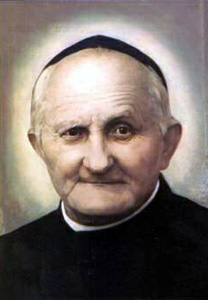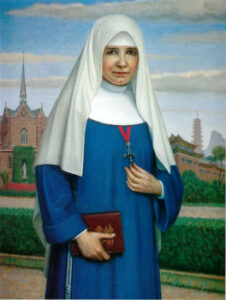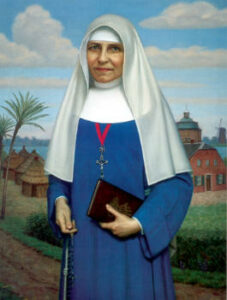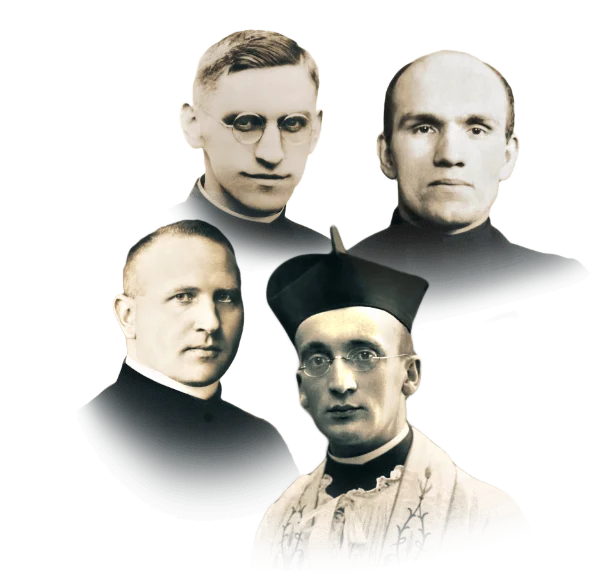 Arnold Janssen was born on November 5, 1837 in Goch, a small city in lower Rhineland (Germany). The second of ten children, his parents instilled in him a deep devotion to religion. He was ordained a priest on August 15, 1861 for the diocese of Muenster and was assigned to teach natural sciences and mathematics in a secondary school in Bocholt. There he was known for being a strict but just teacher. Due to his profound devotion to the Sacred Heart of Jesus, he was named Diocesan Director for the Apostleship of Prayer. This apostolate encouraged Arnold to open himself to Christians of other denominations.
Arnold Janssen was born on November 5, 1837 in Goch, a small city in lower Rhineland (Germany). The second of ten children, his parents instilled in him a deep devotion to religion. He was ordained a priest on August 15, 1861 for the diocese of Muenster and was assigned to teach natural sciences and mathematics in a secondary school in Bocholt. There he was known for being a strict but just teacher. Due to his profound devotion to the Sacred Heart of Jesus, he was named Diocesan Director for the Apostleship of Prayer. This apostolate encouraged Arnold to open himself to Christians of other denominations.
Little by little he became more aware of the spiritual needs of people beyond the limits of his own diocese, developing a deep concern for the universal mission of the church. He decided to dedicate his life to awaking in the German church its missionary responsibility. With this in mind, in 1873 he resigned from his teaching post and soon after founded The Little Messenger of the Sacred Heart. This popular monthly magazine presented news of missionary activities and it encouraged German-speaking Catholics to do more to help the missions.
These were difficult times for the Catholic Church in Germany. Bismark unleashed the “Kulturkampf» with a series of anti-Catholic laws, which led to the expulsion of priests and religious and to the imprisonment of many bishops. In this chaotic situation Arnold Janssen proposed that some of the expelled priests could go to the foreign missions or at least help in the preparation of missionaries. Slowly but surely, and with a little prodding from the Apostolic Vicar of Hong Kong, Arnold discovered that God was calling him to undertake this difficult task. Many people said that he was not the right man for the job, or that the times were not right for such a project. Arnold’s answer was, “The Lord challenges our faith to do something new, precisely when so many things are collapsing in the Church.”
With the support of a number of bishops, Arnold inaugurated the mission house on September 8, 1875 in Steyl, Holland, and thus began the Divine Word Missionaries. Already on March 2, 1879 the first two missionaries set out for China. One of these was Joseph Freinademetz.
Aware of the importance of publications for attracting vocations and funding, Arnold started a printing press just four months after the inauguration of the house. Thousands of generous lay persons contributed their time and effort to mission animation in German-speaking countries by helping to distribute the magazines from Steyl. From the beginning the new congregation developed as a community of both priests and Brothers.
The volunteers at the mission house included women as well as men. From practically the very beginning, a group of women, including Blessed Maria Helena Stollenwerk, served the community. But their wish was to serve the mission as Religious Sisters. The faithful, selfless service they freely offered, and a recognition of the important role women could play in missionary outreach, urged Arnold to found the mission congregation of the “Servants of the Holy Spirit,” SSpS, on December 8, 1889. The first Sisters left for Argentina in 1895.
In 1896 Fr. Arnold selected some of the Sisters to form a cloistered branch, to be known as “Servants of the Holy Spirit of Perpetual Adoration”, SSpSAP. Their service to mission would be to maintain an uninterrupted adoration of the Blessed Sacrament, praying day and night for the church and especially for the other two active missionary congregations.
Arnold died on January 15, 1909. His life was filled with a constant search for God’s will, a great confidence in divine providence, and hard work. The blessing of his work is evident in the subsequent growth of the communities he founded: nearly 6,000 Divine Word Missionaries are active in 79 countries, more than 3,800 Missionary Sisters of the Holy Spirit, and more than 400 Sisters of the Holy Spirit of Perpetual Adoration.
 Joseph Freinademetz was born on April 15, 1852, in Oies, a small hamlet of five houses situated in the Dolomite Alps of northern Italy. The region, known as South Tyrol, was then part of the Austro-Hungarian empire. He was baptised on the day he was born, and he inherited from his family a simple but tenacious faith.
Joseph Freinademetz was born on April 15, 1852, in Oies, a small hamlet of five houses situated in the Dolomite Alps of northern Italy. The region, known as South Tyrol, was then part of the Austro-Hungarian empire. He was baptised on the day he was born, and he inherited from his family a simple but tenacious faith.
While Joseph was studying theology in the diocesan seminary of Bressanone (Brixen), he began to think seriously of the foreign missions as a way of life. He was ordained a priest on July 25, 1875, and assigned to the community of Saint Martin very near his own home, where he soon won the hearts of the people. However, the call to missionary service did not go away. Just two years after ordination he contacted Fr. Arnold Janssen, the founder of a mission house which quickly developed into the Society of the Divine Word.
With his bishop’s permission, Joseph entered the mission house in Steyl, Netherlands, in August 1878. On March 2, 1879, he received his mission cross and departed for China with Fr. John Baptist Anzer, another Divine Word Missionary. Five weeks later they arrived in Hong Kong, where they remained for two years, preparing themselves for the next step. In 1881 they travelled to their new mission in South Shantung, a province with 12 million inhabitants and only 158 Christians.
Those were hard years, marked by long, arduous journeys, assaults by bandits, and the difficult work of forming the first Christian communities. As soon as a community was just barely developed an instruction from the Bishop would arrive, telling him to leave everything and start anew.
Soon Joseph came to appreciate the importance of a committed laity, especially catechists, for first evangelisation. He dedicated much energy to their formation and prepared a catechetical manual in Chinese. At the same time, together with Anzer (who had become bishop) he put great effort into the preparation, spiritual formation and ongoing education of Chinese priests and other missionaries. His whole life was marked by an effort to become a Chinese among the Chinese, so much so that he wrote to his family: “I love China and the Chinese. I want to die among them and be laid to rest among them.”
In 1898, Freinademetz was sick with laryngitis and had the beginnings of tuberculosis as a result of his heavy workload and many other hardships. So at the insistence of the bishop and the other priests he was sent for a rest to Japan, with the hope that he could regain his health. He returned to China somewhat recuperated, but not fully cured.
When the bishop had to travel outside of China in 1907, Freinademetz took on the added burden of the administration of the diocese. During this time there was a severe outbreak of typhus. Joseph, like a good shepherd, offered untiring assistance and visited many communities until he himself became infected. He returned to Taikia, the seat of the diocese, where he died on January 28, 1908. He was buried at the twelfth station on the Way of the Cross, and his grave soon became a pilgrimage site for Christians.
Freinademetz learned how to discover the greatness and beauty of Chinese culture and to love deeply the people to whom he had been sent. He dedicated his life to proclaiming the gospel message of God’s love for all peoples, and to embodying this love in the formation of Chinese Christian communities. He animated these communities to open themselves in solidarity with the surrounding inhabitants. And he encouraged many of the Chinese Christians to be missionaries to their own people as catechists, religious, nuns and priests. His life was an expression of his motto: “The language that all people understand is that of love.”
Source: Vatican’s News Services
 Blessed Maria Virgo (Helena Stollenwerk) was born in Rollesbroich, Germany on Nov. 28, 1852. Already while still at the little village elementary school she began enthusiastically reading the annuals of the Holy Childhood Association, now the Papal Work for Children, in her free time. They roused her determination to help the children of China. When at the age of twenty she tried to follow her calling, she found no convent in Germany that sent missionary sisters to China and for many years she searched in vain for the address of such a congregation.
Blessed Maria Virgo (Helena Stollenwerk) was born in Rollesbroich, Germany on Nov. 28, 1852. Already while still at the little village elementary school she began enthusiastically reading the annuals of the Holy Childhood Association, now the Papal Work for Children, in her free time. They roused her determination to help the children of China. When at the age of twenty she tried to follow her calling, she found no convent in Germany that sent missionary sisters to China and for many years she searched in vain for the address of such a congregation.
During a visit to Steyl she learned that Arnold Janssen saw the need to found a congregation of missionary sisters, although he could not promise that he would do so in the near future. He offered her employment as a maid in the Mission House kitchen. Helena was 30 years old when she accepted his offer. She hoped in that way to reach her goal.
Two years later, in 1884, she was joined by Hendrina Stenmanns from Issum in the German Lower Rhineland. For the first several years the two women worked in kitchen and laundry and lived in a small, very simple house. Years later, when a neighbouring convent became vacant, they moved there. On December 8, 1889 Helena, now Mother Maria and superior general, co-founded with Blessed Arnold, the Missionary Sisters. From then on the development of the Congregation of the “Servants of the Holy Spirit”, as they are officially called, really took off. The rapidly growing community sent out the first sisters to Argentina in 1895; soon followed by a group sent to Togo. After only seven years the Congregation numbered 100 sisters.
Arnold Janssen regarded prayer as an absolute necessity to support mission work. He had long been thinking of a third, contemplative branch for his foundations. So on 8 December 1896 he clothed the first Adoration Sisters in their pink religious habit. In 1898 Mother Maria transferred to the cloistered Sisters becoming a novice with the name Sister Maria Virgo. She would really have preferred to remain with the Missionary Sisters but responded generously to Arnold Janssen’s wish when he asked her to take the step. Helena’s dream, to go out to the great land of China, was never fulfilled. On February 3, 1900 Helen was stricken by a serious illness, she was admitted to religious profession as a Holy Spirit Adoration Sister on her deathbed. On May 7, 1995, she was beatified by Pope John Paul II.
Blessed Maria Virgo’s Motto:
“To God the honor, to my neighbor the benefit, and to myself the burden.”
“If you find things difficult at any time in the future, be comforted by the thought that, like Moses in the Old Testament, there is a Sister before the tabernacle raising her heart and hands to Heaven for you.”
Source: Holy Spirit Adoration Sisters
 Hendrina Stenmanns was born on May 28, 1852, in Issum, German Lower Rhineland, the eldest of seven children. Already as a child, she showed great concern for the poor and suffering whom she visited with her mother. She also cared responsibly for her younger brothers and sisters. After leaving school, she contributed to the family income through her work as a silk weaver. The characteristics for which she was noted, a motherly and cheerful nature, kindness and a healing compassion, began to show in the young Hendrina. She always managed to find the sick and needy, and people turned to her for help and advice in all their problems. Without her being aware of it, God was developing the character and talents she would need for her future tasks.
Hendrina Stenmanns was born on May 28, 1852, in Issum, German Lower Rhineland, the eldest of seven children. Already as a child, she showed great concern for the poor and suffering whom she visited with her mother. She also cared responsibly for her younger brothers and sisters. After leaving school, she contributed to the family income through her work as a silk weaver. The characteristics for which she was noted, a motherly and cheerful nature, kindness and a healing compassion, began to show in the young Hendrina. She always managed to find the sick and needy, and people turned to her for help and advice in all their problems. Without her being aware of it, God was developing the character and talents she would need for her future tasks.
When she was 19, she joined the Franciscan Third Order. That fertile soil nourished in her a spirit of great simplicity both in her prayer life and her dealings with others, as well as trust in God and the readiness to give herself entirely. Her wish to consecrate herself to God grew more as she absorbed the spirit of St. Francis, but the Kulturkampf in Germany made religious life impossible. When her mother was dying, Hendrina promised to care for her younger brothers and sisters. It began to look as though she would have to give up the idea of religious life.
Some years later, through an apprentice of her father, she found her way to Steyl and asked Arnold Janssen to accept her into the Mission House as a kitchen maid. Her real intention, however, was to support the mission cause by her work in the kitchen. When she arrived in Steyl, she was almost 32 years old, matured by the history of her family and her neighborhood. Her letter to Arnold Janssen is an expression of her spirituality and her deep wish to dedicate herself totally to missionary work. She did not have great plans but simply carried out what she recognized as God’s will for her at each moment.
Through her decision to live in the Mission House as a kitchen maid, she stepped down, like her companion Helena, to the lowest rung of the social ladder. A life of hard work and renunciation began that was to last five years as she waited for the women’s foundation. On December 8, 1889, she and a few other women became postulants. The foundation of the congregation had been laid. The novitiate followed and then in March 1894 the first vows. Hendrina was given the name Josepha.
As Sr. Josepha she was responsible for the management of the practical side of things in the house. Later on she became directress of postulants. She showed great understanding of human nature and was able to introduce the young women into religious life with wisdom and empathy. The convent was opened for retreats for women, a significant apostolate that involved extra work for the sisters. Soon language studies and a teacher’s training course were established.
Sr. Josepha was known above all for her love of prayer; she progressed more and more to interior quiet and to true contemplation in the midst of her manifold tasks. The rosary, short prayers, especially “Come, Holy Spirit” became her “mantra”, leading her inward to the presence of God in the tabernacle of her heart.
When Sr. Maria transferred to the adoration sisters, Sr. Josepha became leader of the missionary sisters’ community. In spite of the burden of work and the demands made by a large, young community, she did not lose herself in pure activity. In the depth of her heart she remained in union with God and maintained her inner peace. The final months of Sr. Josepha’s life were marked by serious and painful illness. On her deathbed, suffering from asthma, she bequeathed her spiritual testament to the sisters: The very breath of a Servant of the Holy Spirit ought to be: “Come, Holy Spirit”.
Source: Mission Congregation Servants of the Holy Spirit
 Ludwik Mzyk, Gregory Frackowiak, Stanislaus Kubista, Aloysius Liguda
Ludwik Mzyk, Gregory Frackowiak, Stanislaus Kubista, Aloysius Liguda
On June 12, we commemorate our four SVD blessed missionaries – martyrs. They are victims of the antichristian and antihuman totalitarian system which swept through the world in the 20th century. We remember these four Polish confreres but we also remember all of the other SVD confreres who became witnesses to Jesus Christ in similar situations of violence and hatred. In a special way we call to mind all our confreres killed during the II World War in different parts of the world. Our Society paid a very high price during the war years and many confreres give their lives while attempting to remain faithful to Gospel values. Let us remember the members of the Arnoldus Family in Papua New Guinea, where 122 SVD priests and brothers and SSpS sisters died a violent death. An astonishing 53% of the SVD and SSpS missionaries in Papua New Guinea were killed. In Indonesia 19 confreres were killed. Most of them were of German and Dutch nationality. In the Philippines we remember in a special way Bishop Wilhelm Finnemann (+26.10.1942) who was martyred while defending poor and abused people. The SVD in Poland, the first country in Europe to fall victim of the II World War, has 23 confreres who died as martyrs. Four of them were beatified on June 13, 1999 together with 104 other martyrs (priests, religious and lay people).
Who are these four confreres who have been declared Blessed?
Luis (Ludwik) Mzyk (1905-1940) was martyred as novice master of the Polish Province. After philosophy studies in St. Augustin he was sent to study in Rome where he was ordained in 1932. He applied to work as missionary in Japan or China, but the superiors appointed him for Poland where the SVD need qualified personnel and where the initial formation program had just began. So, he continued his stay in Collegio del Verbo Divino, studied dogmatic theology at the Gregorian University, and finished his study with the doctorate. In the Polish Province he became novice master at Chludowo. Short after the beginning of the war he was arrested and put in the maximum security prison in Poznan where he was cruelly killed on February 20, 1940.
Gregory Frąckowiak (1911-1943). He is the youngest one among the four martyrs and was beheaded in the prison in Dresden on May 5, 1943 when he was 32 years old. As receptionist and bookbinder he showed a special sensitivity to the poor who used to come to him asking not only for material help but also spiritual help. At the beginning of the war in 1939 the SVD house in Górna Grupa where he stayed was closed down and confiscated and the confreres were expelled. He went to his family. Some people were involved in distributing the fliers against the Hitler’s dictatorship. For some time he was also involved in this action but after a time he stopped doing it. The group was discovered and many persons were arrested. It was clear that some would be sentenced to death. Bro. Gregory, after consultation with his confessor, freely presented himself to the police and took responsibility for the distribution of the fliers. Due to his sacrifice some fathers of families were allowed to rejoin their families. Brother Gregory was brought to Dresden where he was beheaded. Many others met a similar death not only in the Hitler’s time but also in the first years in East Germany under communism.
Stanislaus Kubista (1898-1940). He was a mission animator and communicator. His contribution to mission animation is amazing. As director of the SVD printing press in Poland he shared the Founder’s enthusiasm for the printing and editorial apostolates. He edited two missionary magazines, wrote articles and published a book. After his arrest, he was sent to the concentration camp at Sachsenhausen where he was killed with extreme cruelty. According to witnesses who survived, he died maintaining his priestly and religious dignity.
Aloysius Liguda (18989-1942). He was good educator and was often sought out as a spiritual director. As chaplain in the schools he was appreciated and loved by young people. His conferences during recollections and retreats were valued. One of his books of conferences went into three printings. Our reading for the Office of Readings today is taken from his writings. A man of great tranquility and with a sense of humor, Aloysius was of enormous help to other prisoners in the concentration camp in Dachau. In a situation of human horror he was able to help people spiritually and psychologically and encouraged them not to give up. Along with nine other prisoners he was drowned in Dachau on December 9, 1942.
These confreres, victims of inhuman ideologies and persecutions, did not choose their destiny. Like millions of others they were caught up by unexpected events of the times and were dragged along by war, suffering and hatred. They simply tried to remain faithful every day to their religious, missionary and priestly vocation. And they lived out this vocation in the midst of horrors and difficulties. They chose to follow Christ with radical love.
Every generation has to face similar situations, especially missionaries. The martyrdom of our confreres is meaningful for us today. Let us be inspired by their example and turn to them in a prayerful spirit, asking them to intercede for us in our activities that are often so challenging. Today, many of our confreres serve as missionaries in situations in which violence and hatred appear not only in interpersonal relationships but also take concrete historical forms in various structures of oppression or contemporary tyranny.
Konrad Keler, svd
Collegio del Verbo Divino, June 12, 2008

